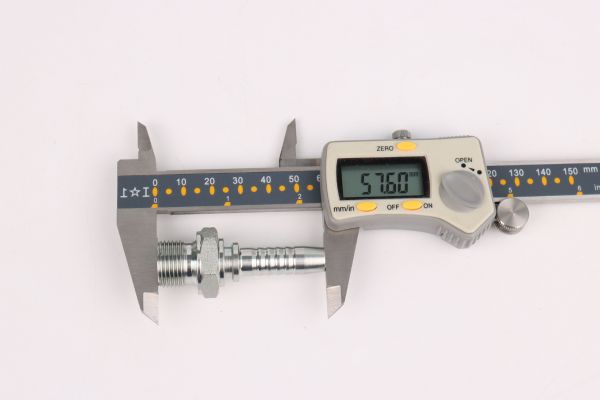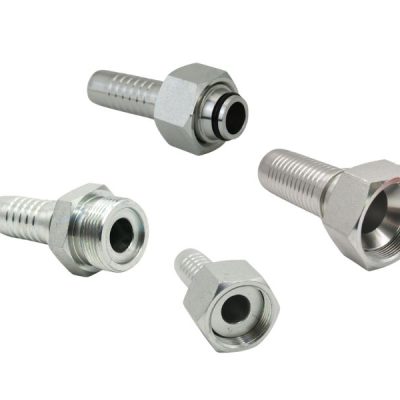Proper identification of hydraulic fittings is crucial for ensuring the safety, efficiency, and longevity of hydraulic systems. Accurate identification helps prevent leaks, minimizes downtime, and reduces maintenance costs. Understanding the different types of hydraulic fittings and their specifications can be challenging, but it’s essential for maintaining system integrity and performance. In this post, we’ll explore the importance of correct hydraulic fitting identification and provide a comprehensive guide to help you identify threads, hose ends, and connectors accurately.
Identifying hydraulic threads correctly is vital to ensure compatibility and prevent leaks. Mismatched threads can lead to system failures, posing safety risks and incurring significant costs. Proper thread identification helps maintain the efficiency and reliability of hydraulic systems. Threads are the critical points where hydraulic components connect, and any inconsistency or inaccuracy in matching these threads can result in significant operational issues. For example, a mismatched thread may not form a proper seal, leading to fluid leaks that compromise system performance and safety. Moreover, using the wrong thread type can cause mechanical stress on components, leading to premature wear and tear or catastrophic failure.
NPT: Tapered threads commonly used in North America. Identified by their conical shape and the fact that they seal by metal-to-metal wedging. NPT threads are specified by the American National Standard Pipe Thread standards and are widely used in the oil and gas industry, as well as in general industrial applications.
BSP: Includes BSPT (tapered) and BSPP (parallel) threads, commonly used in Europe and Asia. BSPT threads taper like NPT but are not interchangeable due to different thread angles and pitches. BSPP threads are parallel and rely on an O-ring or washer for sealing, making them distinct from the self-sealing NPT threads.
Metric: Straight threads measured in millimeters, prevalent in international applications. Metric threads follow the ISO standards and are commonly used in machinery and automotive industries worldwide. The thread profile is typically a 60° V-thread, which differentiates it from other thread types like BSP and NPT.
Identifying hydraulic thread types accurately is essential for maintaining the integrity and efficiency of hydraulic systems. Here’s a detailed step-by-step guide to help you identify thread types correctly:
Begin with a thorough visual inspection to identify the general type of thread. Look for distinguishing features such as thread angle, pitch, and profile. Note whether the threads are tapered or straight:
Tapered Threads: These threads gradually decrease in diameter along their length. Examples include NPT (National Pipe Tapered) and BSPT (British Standard Pipe Tapered).
Straight Threads: These threads maintain a consistent diameter along their length. Examples include BSPP (British Standard Pipe Parallel) and metric threads.
During the visual inspection, pay attention to the thread’s appearance. Tapered threads will appear to have a conical shape, while straight threads will look cylindrical. Additionally, note the thread count (number of threads per inch or per millimeter), which can help identify the thread pitch.

For precise measurements, you will need the following tools:
Calipers: Used to measure the outer diameter (OD) of male threads or the inner diameter (ID) of female threads. Digital calipers provide accurate readings and are easy to use.
Thread Pitch Gauge: Used to measure the distance between threads (pitch). A thread pitch gauge has multiple blades with different pitch measurements; matching the thread to the correct blade determines the pitch.
Accurate measurement of thread size is crucial for correctly identifying and matching hydraulic threads. This process involves precise measurements of both the outer diameter (OD) and the thread pitch. Here’s a detailed guide on how to measure these critical dimensions effectively:
The outer diameter measurement varies slightly depending on whether you are measuring male or female threads:
For Male Threads:
For Female Threads:

Measuring the thread pitch accurately requires using a thread pitch gauge. This tool is designed to match the distance between threads, providing a precise pitch measurement:
Once you have obtained the outer diameter (OD) and thread pitch measurements, the next step is to identify the thread standard. This involves comparing your measurements against established standards for various thread types.
NPT threads are tapered threads commonly used in North America, known for their ability to form a tight seal by metal-to-metal wedging. The American National Standard Pipe Thread standards specify these threads.
Identification:
Measure the OD and Pitch: Use calipers and a thread pitch gauge to measure the pitch. NPT threads typically have a tapered design with a 1° 47′ taper angle.
Compare with NPT Standards: Refer to NPT thread charts to match your measurements. NPT threads seal by wedging the male and female threads together, which makes them suitable for high-pressure applications.
Example:
1/2″ NPT Thread:
OD: Approximately 0.84 inches.
Pitch: 14 threads per inch (TPI).
The conical shape of the threads helps create a leak-proof seal when torqued together.
BSP threads are widely used in Europe and Asia. They come in two main types: BSPT (British Standard Pipe Tapered) and BSPP (British Standard Pipe Parallel). BSPT threads have a tapered profile, while BSPP threads are parallel.
Identification:
Measure the OD and Pitch: Use calipers to measure the OD and a thread pitch gauge for the pitch. BSP threads typically have a 55° thread angle.
Compare with BSP Standards: Use BSP thread charts to match your measurements. Note the difference between BSPT and BSPP threads:
BSPT: Tapered threads that seal similarly to NPT but have different specifications.
BSPP: Parallel threads that usually require an O-ring or washer to form a seal.
Example:
1/2″ BSPP Thread:
OD: Approximately 0.825 inches.
Pitch: 14 threads per inch (TPI).
BSPP threads require additional sealing components such as O-rings to prevent leaks.

Metric threads are used globally and are measured in millimeters. They follow the International Organization for Standardization (ISO) standards. These threads have a 60° thread angle and are identified by their diameter and pitch.
Identification:
Measure the OD and Pitch: Use calipers to measure the OD and a thread pitch gauge for the pitch. Metric threads have a straight profile.
Compare with Metric Thread Charts: Refer to ISO metric thread charts to match your measurements. Metric threads are specified by both their diameter and pitch, which are both measured in millimeters.
Example:
M12 x 1.5 Metric Thread:
OD: 12 millimeters.
Pitch: 1.5 millimeters.
The consistent and precise measurements of metric threads make them suitable for a wide range of industrial applications.
Accurate identification of hose ends and fittings is critical to ensure proper assembly and maintenance of your hydraulic system. The following is a detailed guide to help you identify the different hose end types, fittings, and adapters.
Reusable hose ends are designed with a threaded connection that allows them to be easily attached and detached from the hose. These ends feature visible threads and fittings that can be unscrewed. The fittings typically have a robust, metallic appearance, often with a hexagonal nut for tightening and loosening.
Construction:
Identification Tips:
Crimped hose ends are permanently attached to the hose, creating a seamless and uniform appearance. Unlike reusable hose ends, crimped ends do not have visible threads. The crimped area appears smooth and compressed, often with a series of evenly spaced crimps or indentations where the metal sleeve has been compressed around the hose.
Construction:
Identification Tips:

Male Connectors:
Female Connectors:
Swivel Connectors:
Non-Swivel Connectors:
Correct hydraulic fitting identification is essential for maintaining the safety and efficiency of hydraulic systems. By following the steps outlined in this guide, you can accurately identify threads, hose ends, and connectors, ensuring compatibility and preventing costly errors. Remember to use the appropriate tools and refer to thread standards for precise measurements. Proper identification not only enhances system performance but also contributes to overall operational safety. For ongoing learning, utilize the resources provided and stay updated with industry standards and practices.
To determine the type of thread on your hydraulic fitting, start with a visual inspection to identify distinguishing features such as thread angle, pitch, and profile. Use calipers to measure the outer diameter (OD) of male threads or the inner diameter (ID) of female threads. Next, use a thread pitch gauge to measure the distance between threads.
To identify hydraulic fittings accurately, you will need the following tools:
Calipers: For measuring the outer diameter (OD) of male threads or the inner diameter (ID) of female threads.
Thread Pitch Gauge: This gauge is used to determine the pitch of the threads.
Reference Charts: For comparing measurements to standard thread specifications.
Reusable hose ends feature a threaded connection that can be detached and reused. They have visible threads and consist of multiple parts that can be assembled and disassembled without special tools. Crimped hose ends, on the other hand, are permanently attached to the hose using a crimping machine. They have a uniform, streamlined appearance with no visible threads and cannot be detached once installed.
Swivel connectors allow rotational movement between connected components. To identify a swivel connector, look for a joint or a rotating collar on the fitting. This collar or joint enables the connected hose or fitting to rotate independently of the main body, preventing hose twisting and improving flexibility. Swivel connectors often have a more complex appearance due to the presence of these moving parts.
The most common thread standards used in hydraulic fittings include:
NPT: Tapered threads commonly used in North America.
BSP: Includes BSPT (tapered) and BSPP (parallel) threads, commonly used in Europe and Asia.
Metric Threads: Straight threads measured in millimeters, prevalent in international applications.
Correctly identifying hydraulic fittings is crucial for ensuring compatibility, preventing leaks, and maintaining the efficiency and reliability of hydraulic systems. Mismatched fittings can lead to system failures, safety risks, and increased maintenance costs.